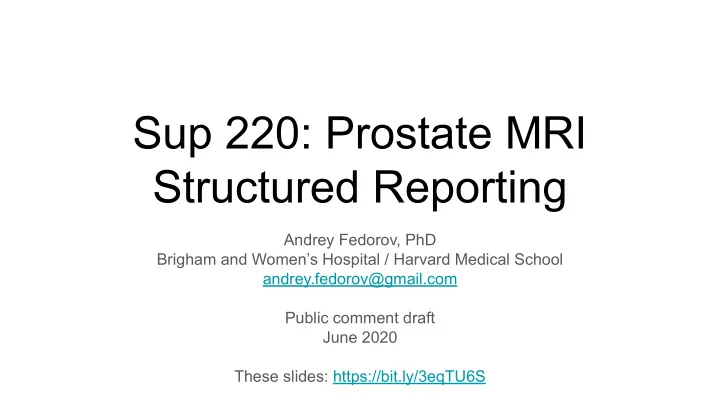

Sup 220: Prostate MRI Structured Reporting Andrey Fedorov, PhD Brigham and Women’s Hospital / Harvard Medical School andrey.fedorov@gmail.com Public comment draft June 2020 These slides: https://bit.ly/3eqTU6S
Disclosures / Acknowledgments This work has been supported in part by the following: ● Research grant from NIH National Institute for Biomedical Imaging and Bioengineering, award P41 EB015898 (https://ncigt.org) ● Research grant from NIH National Cancer Institute, award U24 CA180918 (http://qiicr.org) ● Research funding from Siemens Healthineers / syngo.via 2
Prostate Imaging-Reporting Data System (PI-RADS) 3
mpMRI assessment Purysko, A. S., Rosenkrantz, A. B., Barentsz, J. O., Weinreb, J. C. & Macura, K. J. PI-RADS Version 2: A Pictorial Update. Radiographics 150234 (2016). doi:10.1148/rg.2016150234 4
PI-RADS is more than defining the lesion score ● Clinical consideration (e.g., prior tests, family history of PCa) ● Technical specifications of the acquisition ● Prostate anatomy definition ● Staging of the lesions ● Prostate gland and lesion measurement ● High-level report organization and lexicon ○ Most of the lexicon and PI-RADS terms are availailable in RadLex 5
Motivating use cases ● Structured representation of PI-RADS reports for training AI tools ● Interchange of reports and image annotations between the radiology review workstations and biopsy systems ● Integration of AI tools producing structured PI-RADS reports into the radiology/interventional workflows ● Aggregation of structured clinical evidence documents across institutions for more robust evidence collection ● Integration of structured information annotating clinical findings longitudinally and across radiology, urology and digital pathology sub-specialties 6
Design considerations ● Define framework in DICOM for prostate imaging structured reporting ● Allow for applications of mpMRI interpretation beyond screening ○ PI-RADS reporting as initial application ○ Potential other applications: treatment response, biopsy planning, active surveillance ● Formalize representation suitable for machine learning applications ○ … while keeping many items optional and allowing for parallel TEXT content items ● Heavy use of coded terms as opposed to text sections ● Do not attempt to mirror the organization of the narrated report template ○ Assume organization can be derived by transformation rules from machine-oriented representation ○ Focus on capturing evaluations associated with the annotated image findings ○ Thus approach is different from that adopted for DICOM BI-RADS reporting ● Leverage any existing relevant components of the standard 7 ○ Measurements, image quality assessment, image library
Top-level template organization 8
Findings containers 9
Recommend
More recommend